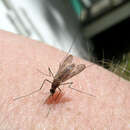Anopheles quadrimaculatus, the common malaria mosquito, is a large dark mosquito, recently discovered through genetic testing to be a complex of five sibling species, so is often referred to as "
A. quadrimaculatus sensu lato". It is native to eastern North America with a range from southern Canada to Florida, west to Minnesota and also to parts of Mexico. Most active in summer months and in warm climates, this species can have up to 10 generations in a year, and overwinters in its adult phase. Its preferred hosts are humans and other large mammals; females will repeatedly bite a host for blood (males eat only nectar). Adult
Anopheles quadrimaculatus frequent houses and other man-made shelters and have a less painful, and thus less noticeable, bite than other mosquito species. Because it prefers clean water for breeding,
A. quadrimaculatus does well in rural swamps and wetlands and produces more adults in these habitats than in smaller containers and ditches associated with humans. This mosquito had the distinction of being the most common vector of malaria in North America until the eradication of this disease from this part of the world in 1950.
Anopheles quadrimaculatus is still identified in vectoring occasional cases of local transmission of malaria in the eastern United States, as well transmitting other disease pathogens such as Cache Valley virus, West Nile Virus and St. Louis encephalitis. It is a common and important host for dog heartworm (
Dirofilaria immitis) and can be a vector for the myositic parasite
Trachipleistophora hominis. In addition to being a disease vector,
A. quadrimaculatus is also a significant pest species in its own right.
Anopheles quadrimaculatus populations can be monitored using resting box collections and carbon dioxide traps. (
CABI 2009; Reinert and Seawright 1997;
Rios and Connelly 2007;
Wikipedia 2011)

